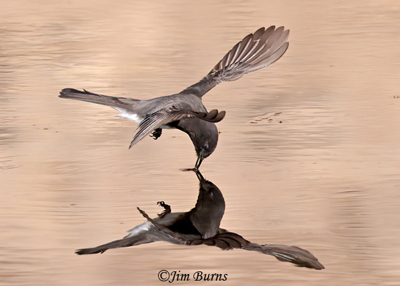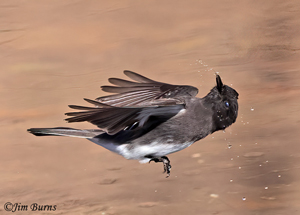
Black Phoebes are common, even in winter, they are always near water and I love the things water can add to an image, and they are constantly in motion on the wing and flight photography is my favorite thing to do. In short, flight shots require a lot of practice and Black Phoebes are my “practice bird.” They are easy to find, typically confiding, and always sallying for insects. I have never seen a Black Phoebe take a single step on the ground. Even when surveying fields and beaches they take to the air, if only for a few feet, feeding over the ground, not on the ground.
To be sure, avian flight has always fascinated me with the sheer beauty of the spread wing feather arrays, but also because various species’ flight patterns and behaviors differ depending on their niche in the environment. Black Phoebes do not fly very high, and I’ve never seen one soar, but I have photographed them kiting low over the water, watching and waiting for emergent insects, I have many images of them at the moment of snatching bugs from the water’s surface, and I’ve documented them diving, banking, and twisting to change course, all within five inches to five feet in the air.
This past winter, as I practiced with a hungry Black Phoebe, I captured images of flight behavior I’d never seen before in any species associated with water, and I could find nothing in the literature detailing or explaining what I saw on the screen. On three occasions the back of the camera showed the phoebe, in the very first frame after snatching insect prey from the water’s surface, twist its neck so the bill holding the captured bug pointed upward for a moment. The bird then leveled out immediately and proceeded to a perch to enjoy its protein morsel.
My best guess is that this rather awkward looking maneuver, avian aerial gymnastics as it were, serves one of two purposes. Either the phoebe turns its head upward momentarily so that gravity keeps the catch from escaping, or the bird is letting the water droplets on the prey fall into its throat to facilitate the digestion soon to follow. Thinking back on my many Black Phoebe observations and checking my photo files, I found plausible corroboration for either or both these theories.
The first is that I have never seen or photo captured a Black Phoebe making this head movement after simply snatching an insect out of the air at which time the bird would be flying horizontally or even upward. In those cases the prey could not drop out because the speed of the bird’s flight would force the prey deeper into its mouth, whereas in capturing prey off the water’s surface, the bill is necessarily pointed downward, and the bird must momentarily stall its flight to make the snatch, so its air speed is much slower.
Secondly, I’ve often seen and photographed water birds after consuming aquatic prey, or passerines after swallowing grain or fruit, then proceed to a water source and drink. It’s a predictable behavior I’ve come expect as I look for opportunities to document interesting photogenic avian action—visible droplets falling as a bird lifts its head from water. However, I’ve yet to capture a Black Phoebe doing this. I’ve never even seen or photographed a Black Phoebe drinking, though they’re always near water.
This column is meant as yet another reminder there can be a lot more to birding and observing the avian world than keeping a list and making that list the reason you’re out there. I often and freely admit it took me many years to realize this, but being in the field seeking to understand behavior and the interconnectedness of birds and our environment has added so much to my enjoyment of our birds. It’s not about your list. It’s about discovering how and why the life around us works.
The Snatch

The Neck Twist